My observations of crows began around November, 2014.
Now in 2020, I have added corrections and commentary. I am always learning, and my corvid friends keep teaching me.
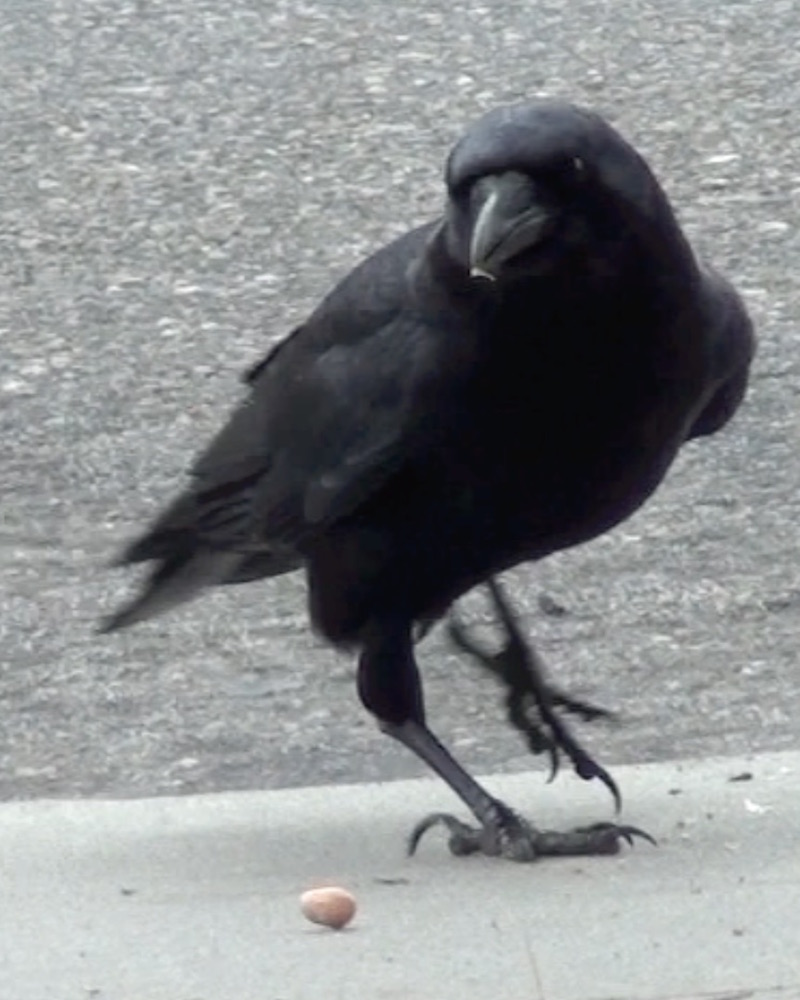
It started when my wife Dixie gave names to the three crows that were typically hanging around near our house, Heckel, Jeckel and Larry. This may have been around 2012. We enjoyed their company, although they were shy and very wild. We assumed they were a mated pair and their “teenager” from the previous season. Around that time, we re-watched a very good documentary on the PBS Nature series, “A Murder of Crows” (https://www.youtube.com/watch?v=EpPCCwBKSgo), which originally aired in 2010. I researched the best treats to feed these wonderful birds, in order to start making friends, and read that raw peanuts in the shell were a healthy favorite food for them, with the advantage of being cheap, portable, biodegradable and easily flicked with the finger a good distance. They also make a pleasing clicking sound when they land, which helps the bird identify the treat. We confirmed this when we saw an elderly gentleman near the park where we sometimes play tennis. We noticed that he had a satchel on his shoulder, and sometimes he would surreptitiously pull a handful of peanuts from his bag and drop them in the street. Six or eight crows in the park were watching closely, would follow him when he approached and quickly descend on the small pile of peanuts.
I noticed in the autumn, when the black walnuts were ripe, that crows would drop them in the street hoping for a car to roll over them, because the shells were too hard for their beaks to crack open. As an experiment, I took a hammer to one of these walnuts, as a crow watched me from a tree. The crow never approached to investigate the crushed walnut. It didn’t trust me. The small pile was still there that afternoon, when a squirrel discovered it.
Scruffy and Scruffette eventually figured out that I’m offering treats. I think I can tell the males by a larger size and a slightly higher brow-ridge over the eyes. The female puts her head down asking for preening, stepping closer on the telephone wire, while he steps away in a clueless sort of defiance. The couple is more shy than the visiting small flock of competing crows. Later, when the crow-crowd figured out there was a good thing here, the two would stay and watch from a distance or fly away. I later came to assume that the crowd consisted of their offspring, in-laws, grandchildren, nieces and nephews.
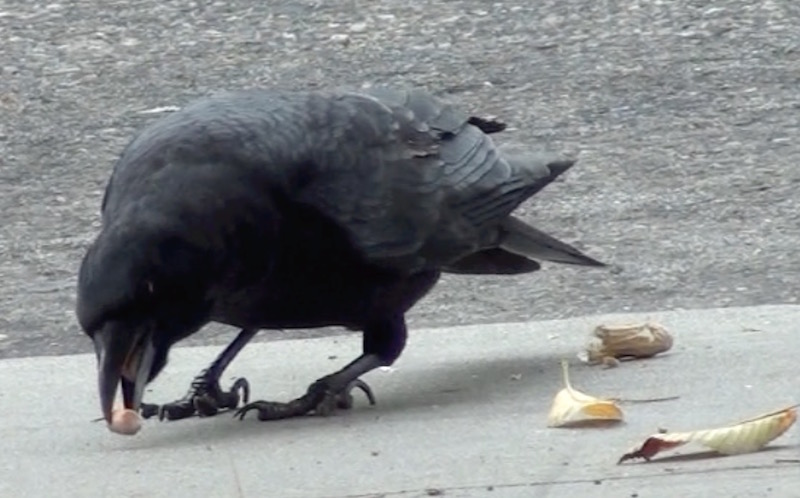
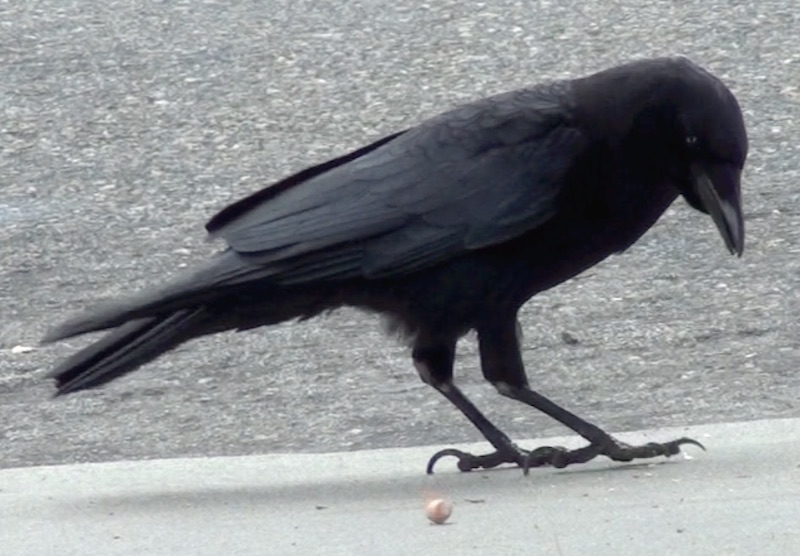
December 30, 2014: The blue-jays have caught on to the game and they have started trumping the crows in the peanut chase. We’ll see how that evolves. They are so bold they allow me to walk up to the tree they are in, place a peanut on a branch three feet away and stand there. The jay will fly down to get the nut and fly off quickly, not really afraid of me at all. Now they get to the nuts I throw in the street, faster than the crows, who remain distrustful. Already, the crows might be figuring out that they have to get to the gift faster, or it is stolen from them.
========
Email to Simon in Victoria, Australia:
I think our various crows are somewhat similar around the world. I have seen stories about how the New Caledonian Crow (from the island near New Zealand) may be one of the smartest non-human animals on the planet. Ours are pure black (I think yours have white markings on the wings). Ours are large, but not as large as a raven, species name is Corvus brachyrhynchos. Typically about 40-50cm tall. I love how completely individual they are, with the mind of a criminal. They are very cautious, utterly wild. I don’t pretend for a second that I am “taming them.” I imagine perhaps that I am slowly earning their trust, as a good sucker to steal food from. The blue-jays on the other hand – also very smart aggressive birds – behave like utter bullies, quicker and more risk-taking than the crows. In comparison, the crows seem sophisticated, like mafioso compared to the street-thug blue-jays. The jays would hit you over the head for the coins in your pocket, but the crows would con you into giving them the keys to your car. I feel that the peanut feeding is merely letting me get closer to them, to observe their social behavior a bit better. I have seen the parenting practices of mom and “teenager” and also the way they keep territories marked off by human details like the street and sidewalk. They differentiate the curb as a crossing zone into another space, while they feel safer out with the cars in the middle of the street. The lawn is a very risky place in their minds, the place where people stand and watch, or dogs roam. They go there to dig for grubs in the early morning when people aren’t around, but they prefer the street or the branches above.
It’s an endless study. I’m enjoying it! – RR
========
Feb 1, 2015
Blue Jays have become the intervening factor. They are bold enough to steal peanuts off of my shoe, or on a table right in front of me. The crows have noticed this as well, and they have learned to swoop in faster to get their target. Both species have been perfecting different flight patterns. The blue jays take fast dives in from tree branches right above me, but they steer away if a crow gets there first. The crows use a drop flutter, where they let gravity drop them down and use their wings to stop the fall, often about ten feet away from the peanut. Then they strut toward the target in a way that prevents competition. However, if there is anything threatening in the environment, the crow will fly over the target and return to a branch nearby, usually letting a jay swoop in to get the nut. The crows are cautious, more shy, willing to drop the target for safety.
To avoid the jays, I have taken to walking around the corner. The jays do not follow farther than a few houses. The bolder crows have learned to follow me all the way to the park. They get much better food around the corner, away from the jays. My only problem is passing cars and pedestrians. I don’t want to scare people about my crow-feeding and I don’t want a crow to get hit by a car.
Around January 26, I turned some sprinklers on in the back yard and I noticed the crows were drinking and bathing in the spray. They usually avoid the back yard, but my feeding has made them more bold. I flipped a few peanuts to the washing crows, and they found them. They know me and trust me more than they trust most humans, and they know our house now. A few days later I saw them poking around in the back yard, so I went out and tossed some peanuts. This is more common now. The boundary is getting softer. I don’t know if this is a good thing. It could be a problem when we start growing food, but for now I am very interested in the experiment. They do know our boundaries, and they prefer the public space. That is very interesting.
Today, two crows were in the magnolia tree, and I put a few peanuts on top of the fence as they watched. The first two nuts were taken by blue-jays, then a crow came down and ate the remains, watching me watching it. Fascinating development.
==============
Away on tour for two months in springtime, 2015. Curious if they’ll remember me upon return. Back around mid-May. It takes about a week, going on my daily walk, for the familiar crows to start checking for me again. By summertime, we have a regular routine of morning walks and various individuals showing up at their typical spots. Some follow me around town.
Starting in October or November, the groupings get larger. These are the juveniles, I think. They are not so bright, and a bit clumsy. Two groups catch on to me, one group hangs out in the empty lot on WG (a good spot to look for bugs) and the other group of about 20 birds convenes here at our house. That’s the group I record for use on my next album “What We Left Behind.” In fact, the low-status youth I call Mep is featured in the gap before the final song on the album, and at the very end of the album in a minute of near silence. You can hear the “mep” sound clearly. (2020 comment: I have come to recognize this “mep” sound in many of the crows that follow me, and I think is is a begging sound that they make because I am offering treats. It might indeed be from juveniles or subordinate birds, but it occurs most often when they are following me for treats, so I assume it is a sort of begging.)
By late winter, Roofus has shown some other crows that they can look into my office window from the roof in the morning, when I am doing email and sipping coffee. I can see their shadows walking along the roof, and hear them above my head. I’ll step outside and throw a few peanuts on the concrete patio by the back door. They drop down from the roof while I am still standing on the steps, and actually come toward me to grab additional gifts that I flick to them.
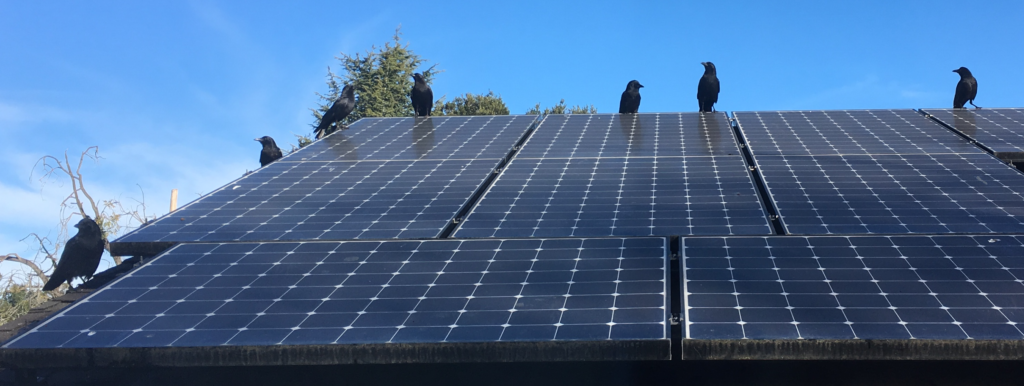
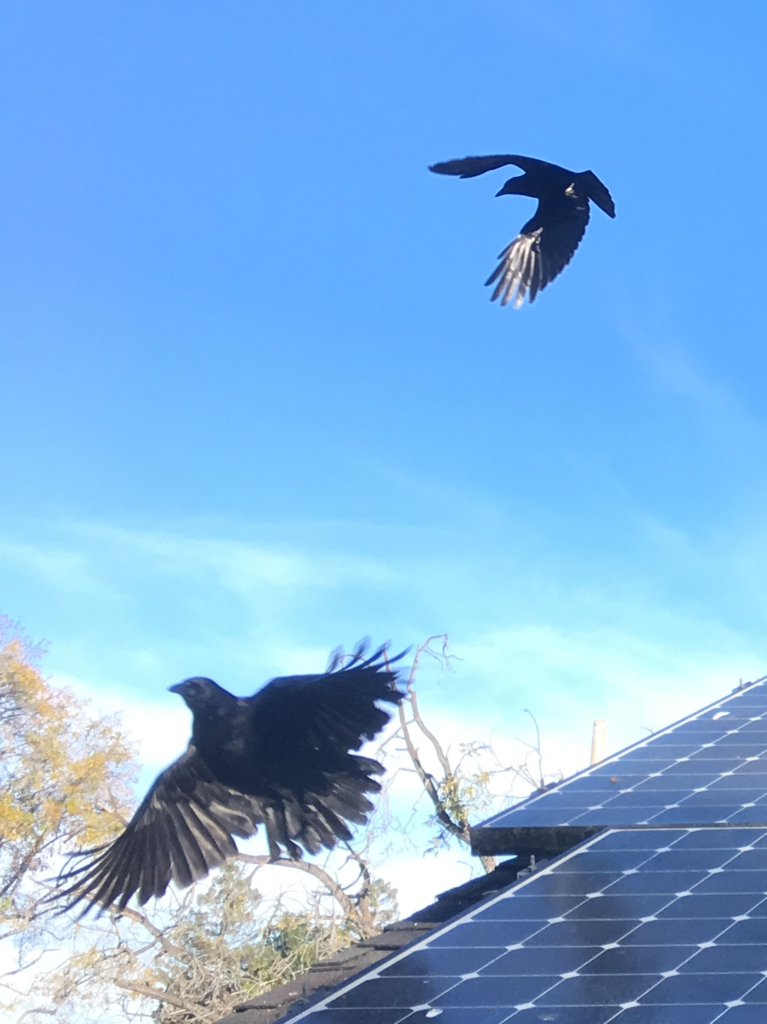
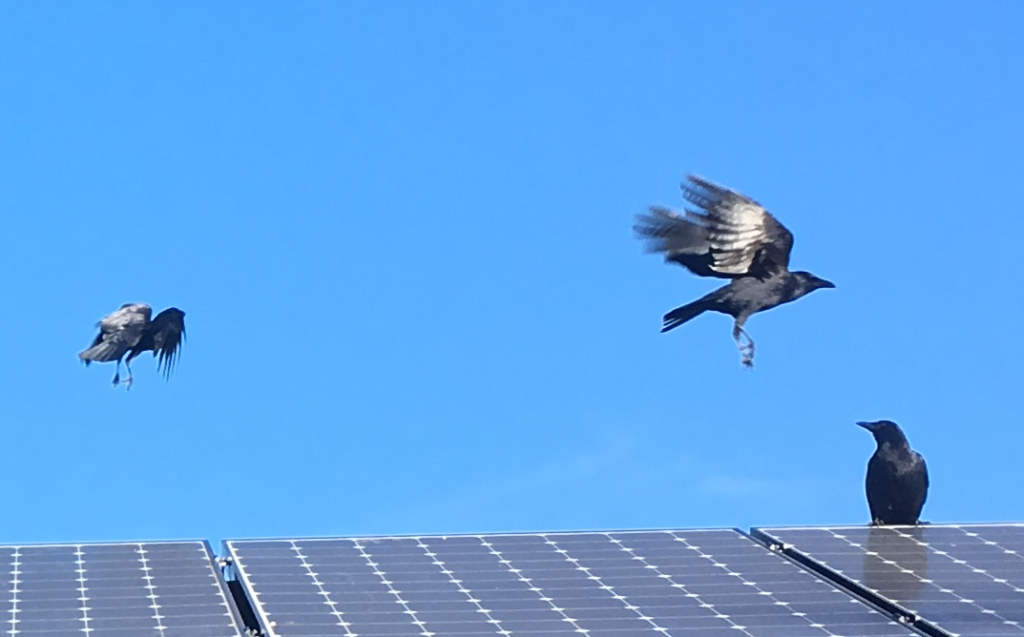
I have a bowl of water set out near the front walkway, and I find signs that they are using it to wash throughout the day. There are little white globs left in the water from their washing. At first I had no idea what these fatty globs were, and I have come to learn that they are probably saliva, which is quite thick and waxy like this because they use it to preen their feathers, and it helps them stay waterproof.
Also in this early spring, I start noticing a few gifts showing up. I was in the front washing out the bowl when I noticed (maybe Roofus?) dropping an object onto the garage roof. It’s a powder-blue bic lighter, the half-sized variety. A few hours later, the lighter is relocated over to the water bowl. Clearly it’s a gift. A week or two later, I find a part of a cooked lobster tail shell sitting in the bowl of water, which may have fallen out of a neighbors garbage and offered a bit of food for a bird. Perhaps the crow placed it in the water thinking it might soften? I remove the lobster shell and place it next to the bowl. It is gone an hour later. During April I also find a chicken thigh bone and a half of a corn tortilla shell sitting in the water. In the case of the tortilla, it seems clear that it is soaking there to soften. I remove it again, rinse the bowl, and place it by the side. It also disappears in a short time, certainly eaten. A piece of red plastic has also shown up nearby, a blue plastic button, and a gumdrop-shaped green glass marble. I am pretty sure that at least a few of these are gifts, and not food meant to soften in the water dish.
==============
May 8, 2016
Many familiar individuals in the neighborhood now. During the winter, the juvenile mob would hang around in the front yard, and some of them much more bold than others. Able to identify individuals from their behavior. Belly has a habit of looking down underneath herself in an upside-down way. Roofus was the first to learn that he could ask for peanuts on the roof and catch them when I toss them up onto the roof. It’s a bit of a game I think. He would look into the dining room window while we sat there, from up above on the front door overhang. (2020 note: I think Roofus was one of the yearlings from the first time we started feeding the family, so he learned to trust us when still young. He then taught many of the others that they could play a game of “catch the peanut” on the roof, with me flicking peanuts from the back porch. This game is still happening four years later.)
Come early springtime, they start getting more aloof from each other and from us. They become more territorial, and I can see them chasing each other away sometimes. The same couple remains, waiting on the telephone wire above our driveway (Scruffy is the male, his wife Scriffette rarely seen this season, probably tending eggs or chicks nearby. Scruffy got his name because he used to have a “cowlick” feather on his left wing, that would often stick out in an unruly way. It might have been molting season.) Scruffy is always a bit shy, waits for me to go back through the gate before coming down. I’m rather sure these are the same individuals we started feeding in 2014. There are others that come by rarely, but they are not welcome in Scruffy’s territory. They stay mostly around the corner, where a pair of mockingbirds is ruthlessly attacking them all day long. If Scruffy is away, one of them sometimes comes around the corner to request a snack, but Scruffy will chase him away if the interloper lingers. (2020 note: these interlopers are possibly children from previous years. When the clans get more social in Autumn, I think I see them hanging out in more friendly ways.)
The one I call Belly has a mate and lives in pine trees at the edge of the creek, in a wooded area. She is very familiar with me, and when she notices me walking through the park, she’ll come up to a nearby branch and wait for her snack. Yesterday she actually met me on the railing of the bridge, at eye level just a few feet away. Her mate is a bit less familiar, but will follow me over to a quiet spot behind some dumpsters to join Belly for peanuts away from playing children. These two might have been in the same spot of the creek last year, with 2-3 young, when the creek was dry I would toss them peanuts from the bridge onto the creek bed below. They taught their young that I was OK, and perhaps their young were among the individuals who visited our house in winter. It seems clear, though, that our house is Scruffy’s territory, so they only come around at length in Autumn when everyone is more social.
As I go on my daily walk, I pass a pair of crows that know me on C-ave., and one of them often comes quite close and waits on a stop sign (or a nearby branch) so I call him StopSign. He and his mate probably live in the tall redwoods in the middle of the condo complex that dominates the block. Another familiar group of crows lives on the way downtown and meets me on WG, parallel to the expressway. They often show up from trees in the median strip of the expressway. I don’t call them – they know what I look like and they show up quietly with an understanding that I carry food. A few of these are the most daring. I have named one of them CarTop, because several times now, he has landed on the roof of a parked car right next to me as I walk past. The first time he did this, I made the mistake of stopping and looking directly at him. This is very rude in crow language. Direct eye contact is an act of aggression. He flies away if I do this. So I have learned to glance just long enough to notice him, then drop a peanut close to me as I keep walking. He’ll come right up to get it if I don’t change my pace. Now, he’ll often land on the ground just behind me, and I only know he’s there by the shadow and a slightly audible whoosh of his wings. If I stop to look, he gets a bit spooked. It’s all about body language, seeming to be uninterested. Other crows will follow me across the busy intersection and meet me in the trees by the train station, and some will follow me all the way down to the post office, knowing exactly who I am among hundreds of different pedestrians.
(I have learned that the crows will find me even if I drive to the post office, without my usual hat and backpack that I wear when I walk. I will get out of my car, and notice one of the crows nearby shift its behavior and fly right up to a branch over my head. They recognize me even when I don’t have my standard visual appearance. Therefore I often carry peanuts in my pockets wherever I go, just in case they recognize me in public.)
==============
May 18, 2016
As I would be traveling for a few days, I wanted to make sure I said hello to my various friends. On my walk, Belly and her mate are very quick to fly over to me as soon as they see me cross the bridge. They don’t seem at all bothered that Dixie is also walking with me. Belly flies up to an often-used branch above the bridge post, where she watches me place two peanuts on top, at my head-level. As soon as I step away she hops down to retrieve them. This is a rather common spot for us to meet. As expected, four crows follow me down WG and act bold like adolescents. CarTop is here too, and stays separate from the gang of four. This time he lands on the fence right next to me, puffs out his wings sideways to look bigger, drops his body down a bit and makes two low loud caws, clearly to get my attention. I have seen a certain crow in my large winter home grouping do this same maneuver and I wonder if it’s a dominant behavior. It certainly seems macho.
I make a faux-pas (crow-pas?) back at home with our shy Scruffy. I’m working in the studio and see a familiar shadow pass over the skylight. I figure I’ll go drop him a peanut. When I step outside I don’t see him up on the wire. It’s a very hot day, so it occurs to me he might be down at the bowl of water I keep filled for them. I peak my head over the fence, and see Scruffy just as he is cautiously stepping sideways to the water bowl. He looks up to see my face over the fence and his eyes widen in fear. He jumps into the air and flies up to his spot on the wire. By way of apology, I drop two peanuts under him on the driveway, and also two by the water bowl. He looks down at the ground, bowing his head more than he usually does when I drop him a snack, but then he flies away back to his roost in the tall redwoods. An hour later the peanuts are still untouched by the bowl. I felt rather sad that I had startled him so badly just before I have to leave for a few days. I find it fascinating that the one crow who spends the most time at our house and knows us the best, also maintains a very clear distance and stays more shy than the ones that know me as I pass on my walk. I can only imagine that it relates to a sense of territory, perhaps he knows that his territory overlaps with mine and he needs to respect those boundaries. I think he understands that we are different species, and he gets a benefit from my snacks. He even calls me to announce his arrival and request a snack; but he won’t get close.
That evening, about an hour before sunset, Scruffy re-appears with his mate, and announces his arrival with several loud caws. I step out to see them both up on the wire, close to each other side by side. I drop a few peanuts and go back inside. Scruffy retrieves two of them, leaving one for his mate, and flies away. She drops down a moment later and gets hers. Am I forgiven now?
==============
May 23, 2016
I was traveling for four days, and when I got back things have changed with our local crows. It’s fledge time. Scruffy and Scruffette are coming to our house more often, and together. Until this week, Scruffy was usually coming alone – I presume because Scruffette was tending the chicks. They call when they show up, to let me know they’re here. Yesterday (May 22) they had one of their fledglings with them. This is our first introduction. I’m calling him/her Scruffzilla, due to the demanding behavior. The parents are a bit more bold than they were last month. They wait across the street (not waiting exactly, but poking around in the gutter near a discarded drink cup – perhaps there’s some sugar water in the puddle next to it?) Scruffy also makes a rare appearance in our back yard this morning, just checking around for food sources. I don’t think he found anything. But yesterday, moments after I tossed a couple peanuts, baby Scruffzilla showed up on the phone wire and made begging sounds, while Scruffy placed shelled and broken peanuts into his/her beak. I heard the telltale “Reyh” baby-begging bark from the fledgling. It’s an upward pitched higher sound, nasal and almost cat-like, clearly a baby asking it’s parents to feed it. If my observations last year are an indication, this might continue all Summer into Autumn. Crow parents are hard-working and patient, with very demanding babies who grow almost to full size within only a couple months. In fact, even now. Scruffzilla is almost the same size as Scruffette, the mother. It’s hard to imagine a bird growing so quickly then taking another year to start acting like a young adult. The growth stages are different from ours, and terms like “baby”, “teenager” or “young adult” seem out of synch with this particular pace of development. Like many intelligent species, though, they develop physically much faster than they develop psychologically. The young might almost look adult, but they are clumsy and shy, afraid and inept, the word “dorky’ comes to mind. It makes one realize how many of these skills are learned and not innate.
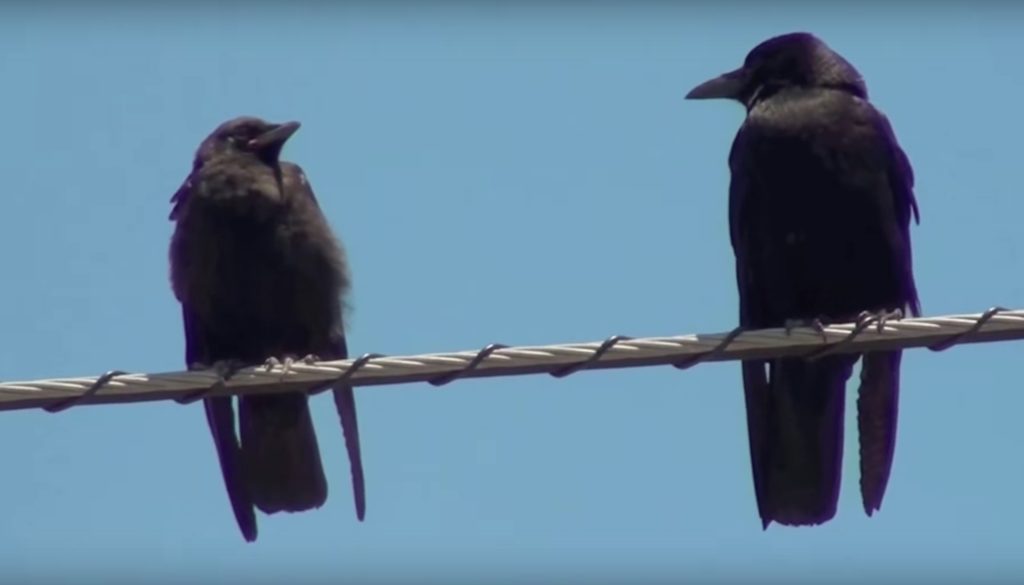
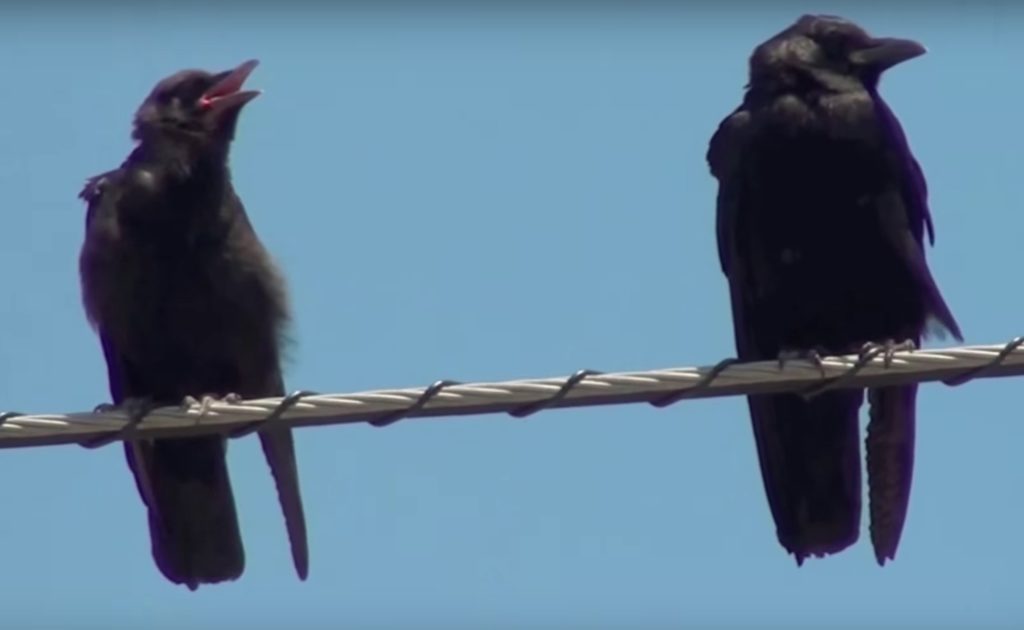
==============
July 9, 2016
Watching a cute bit of play behavior with Scruffzilla. I came outside when Scruffy cawed (which he does to announce his arrival and desire for a treat.) Scruffy is up on the phone wire with one of the fledglings (‘Zilla 1 or 2) next to him. Scruffzilla is playing with a dry leaf up on the phone wire. He has it in his beak and it’s rather breezy. He places it under his claw to hold it down against the wire, then intentionally (?) lifts his claw and tries to catch the leaf as it lifts up in the breeze. He doesn’t quite catch the leaf and it flutters away. Then he makes some quiet gurgling and clucking sounds either to himself or to his father perched near him. These soft babblings are very different from the loud begging sound that Scruffzilla makes when a parent is nearby. He seems to be playing and talking to himself. There is a definite sense of curiosity and learning in his environment.
==============
January 17, 2017
For the last six months, the local crèche has become increasingly comfortable around our house. Dixie isn’t so happy about it, because they tear at any interesting fiber that protrudes from the ground, including tarpaper from the roof and garden cloth under the gravel pathways. One or two crows look into my office window in the morning, when I do email, hoping I’ll notice them and come outside with peanuts. Scruffy and Scruffette – lifelong mates – are courting again for the season, doing the nesting dance. I watch them re-acquaint themselves, getting increasingly close to each other, perched on the benches in our back yard while I filmed them from inside my office. Now he preens her neck feathers after she snuggles up close to him and bows her head down. I posted some edits of their courtship on YouTube with a bit of music from my album Open Window (below.) My challenge at this point is to figure out how to keep the whole crowd of crows friendly while shifting their expectation away from a free-for-all.
==============
February 14, 2017
Scruffy and Scruffette are so cute this week. I edited together some video of their allopreening that I took from my office window while they perched on the garage roof in front of me.
I am a bit worried that they get too aggressive with each other, competing over the treats. They make a game of catching peanuts in mid-air, but if they miss one, there is a scrabble between them to fetch it. I don’t want anyone to get hurt. Also I notice one individual with a disease on her legs. I call her Whitefoot. I think she has an infestation of microscopic spider mites (called scabies if a human gets it) and it probably itches horribly. It is also contagious, if that’s what it is. I feel a sympathy towards her and I want her to get something to eat. I see the other birds shunning her to a certain extent. I want to make sure her infection doesn’t spread to the others in this close proximity, but I wonder if she gets better nutrition maybe she’ll be able to fight off the infestation. It’s tough being wild, without doctors or medicines… and I don’t think catching her for a vet visit is an option. In the meantime I am going through large quantities of peanuts to give treats to over 20 crows – sometimes a pound per day.
==============
April 10, 2017
Since last writing, the crows have gone scarce and shy. It’s nesting season. Scruffy and last year’s Scruffzilla (teen helper for this year’s brood) do know where to find a good snack, though.
I made some katsu stock with smoked pork neck bones two nights ago, and yesterday I started putting the scrapings of smoked pork icky bits into a dish by the water bowl, with raw peanuts as an offering. The pork was gone in minutes. (They wait on the phone lines until I go inside, and they can tell if I am watching in the window. During nesting season the Scruffy family gets very wary.)
This morning I found a bright pink plastic fragment on the patio. I assume it’s a thank-you note. I think they are telling me that they like smoked pork bits. Also I think I saw the tree where they are nesting. This is a first after 4 years of knowing them. They are a successful family of city crows that keeps their privacy – even from human friends – because they are smart and trust no human, even me.
==============
April 22, 2017
Interesting crow day today. Many of my friends were more bold today, walking right up to me to request a peanut. Yet they seemed very feisty and territorial with each other. I must assume it’s nest related.
This morning I stepped outside to check the mailbox, and the corner crow flew up onto our lawn and began walking right towards me as I was filling their water dish. Suddenly Scruffzilla (the yearling who has mostly been owning our peanuts) swooped down to chase the corner crow away from me, as if our lawn was off-limits to a different family. After an intense moment of acrobatics, corner crow hid under the branches of our gangly elm tree, on the low fence. I gently walked to that area, and he came up towards me along the fence line, very calm and trusting. I dropped some peanuts and went inside.
Along my walk, similar things were happening. Aerial acrobatics of families chasing single crows away from their territories, and the single crows acting much more friendly and bold towards me than they did last month. Is it out of hunger? I hear nestlings begging in the distance, so I know everyone is working hard to feed gaping squawking mouths. Is this a battle over resources or territory? I am so happy to have this glimpse into their complex social lives.
============================
May 3, 2017
The midday calm is shattered by a growing chaos outside, as crows from all over the neighborhood are circling around the top of one of the tall deodora cedars across the street. Several of them are dive-bombing at an invisible target, which can only be a hawk trying to scope out the neighborhood from a tall perch. I was able to make a quick and sloppy video with my phone.
A few months later, I was able to take some photos of the same hawk on a nearby tall cedar. this particular hawk had the markings of a juvenile, and I had seen it show up on the same branch all year long. Most of the time, the crows leave it alone. I am rather sure that the aggressive mob in May had grown so large because of the presence of baby crows nearby. They become increasingly defensive when their babies are threatened, and have been known to dive-bomb unsuspecting humans as well.
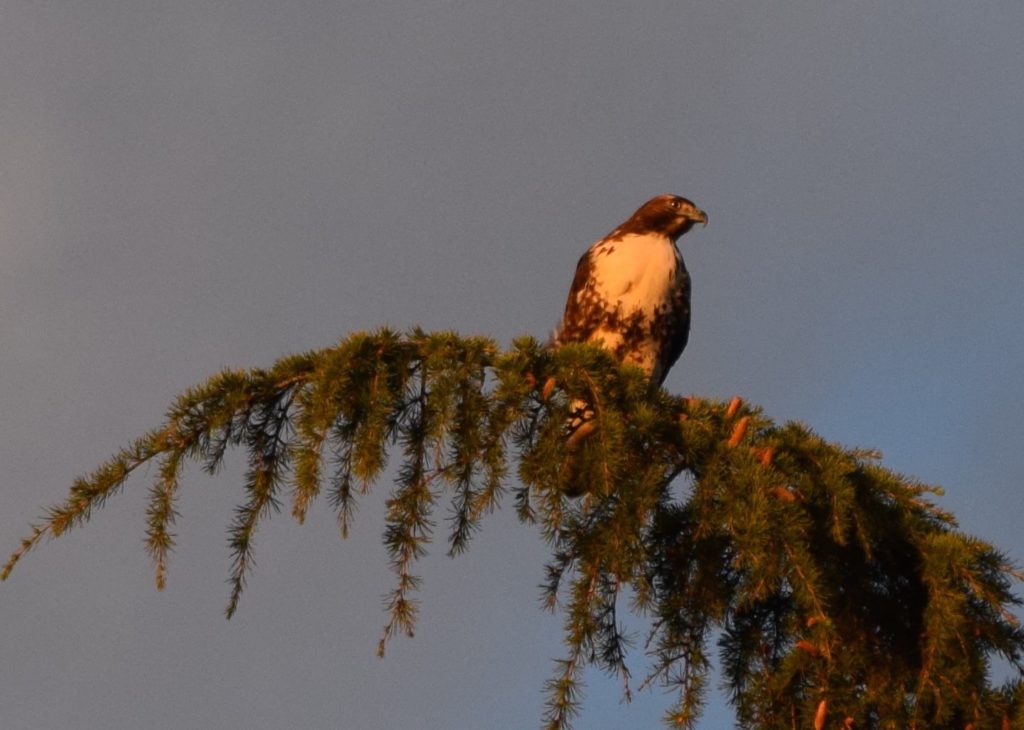
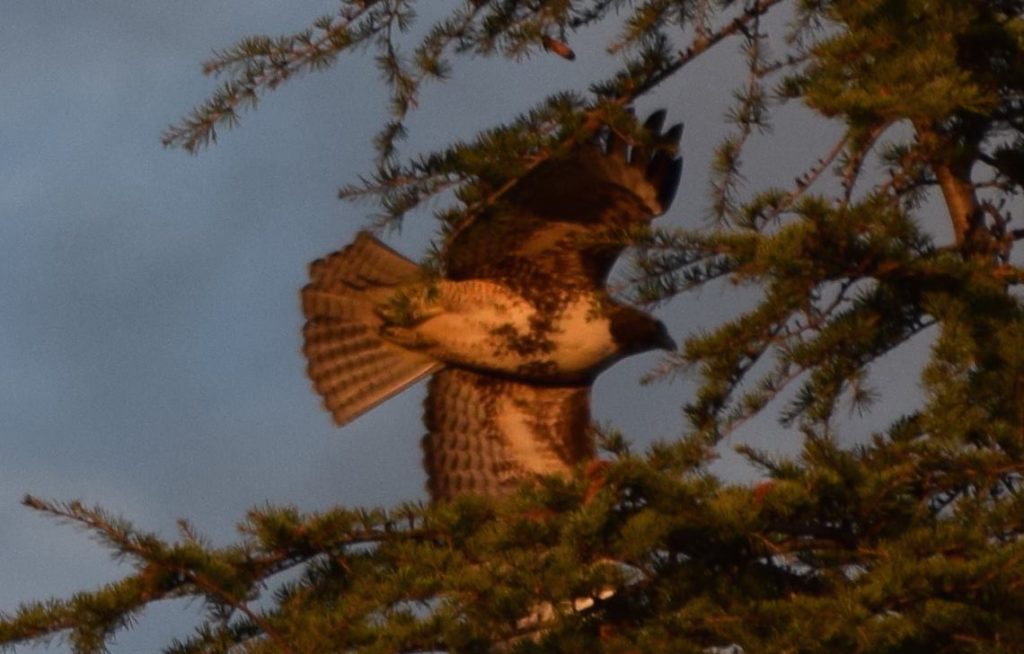
============================
June 22, 2017
Hot weather this week, slightly cooler yesterday so I was able to take my usual three mile walk. The return trip follows a public trail along the creek, a riparian corridor between freeway and apartments. Several of the crow families know me here, and they’ll show up in certain places where I look for them and give them a treat. I paused at a spot I call “squirrel city” with deep coverage of live oak. I heard crow babies begging from a large camphor tree in the distance, maybe 100m. I gave my whistle and waited. First an adult flew a few branches toward me, then another adult, then the babies, working their way toward me as a group in several stages. Five crows congregated in line on an oak branch over the creek, 10m away facing me. Mom and dad were introducing their three fledglings to me. I glanced up then looked down at my feet, as a polite way of showing I am not a threat. Now that we were formally introduced, I quietly placed a peanut onto each of a half-dozen fence posts running along the trail, and walked away. From a distance I saw an adult take a peanut and show the fledglings how to crack and eat it. They began calling for food, still a bit young to do it themselves. The babies received a formal lesson in cautious human interaction. These small moments give me great joy.
============================
July 25, 2017
Today I was on my walk, and I paused for a man to pass me while walking his dog on the same street. He saw the crows following. He looked fascinated. I said “Sorry, I’m only pausing so your dog doesn’t scare them. They follow me around.” As an explanation, I tossed a peanut and there was “Stop Sign” the crow trusting enough to grab it, dog on leash in sight. Dog-walker smiled said “Nice!” and moved on. His path was parallel to mine, and we found ourselves on the same streets for a while. He watched as my little ragtag community of molting black feathers followed, asking for treats. Waiting for the light at a major cross street, with six crows on the wires overhead also awaiting the red light (so they could follow me to the train station) I joked to him, “If you ever feel paranoid, like eyes are watching you from the sky, you can know that it’s actually true. They really do watch us, and they can tell us all apart.”
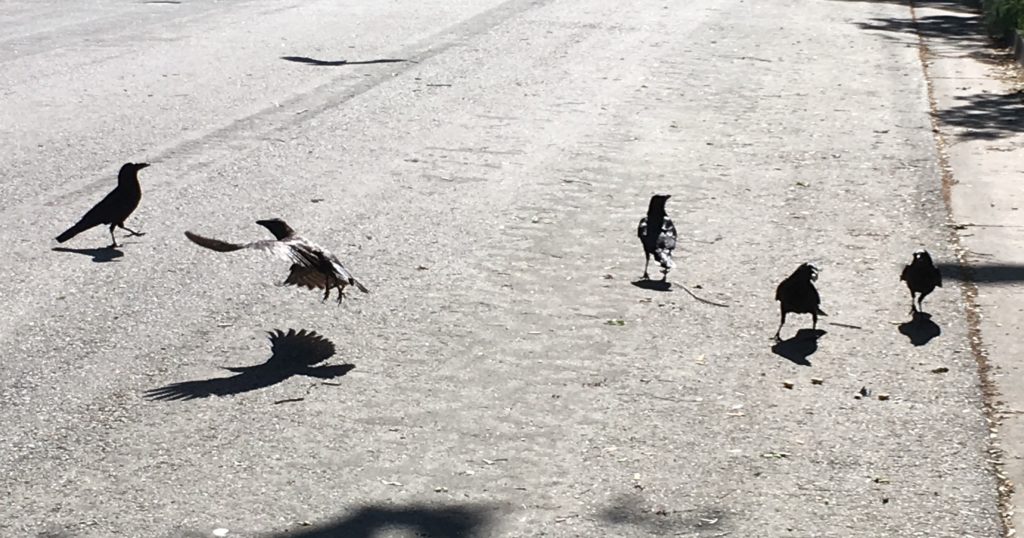
============================
January 15, 2018
I discovered one of the juvenile crows downtown mimicking a human “Hello!” and I managed to get a quick video of it with many of the others that tended to follow me as I go on my walks. rather surprisingly, Dixie was with me this time, and usually they are a little bit more shy when I am with someone else.
Then several days later, the same crow followed me over to my friend’s coffee shop, and perched on a branch above the front door. This time, not only did the crow mimic “Hello” but it also copied the sound of laughter from a table of coffee drinkers nearby. (You can hear the chuckling sound at around 22 seconds):
============================
January 3, 2020
I continue to see the pair of ravens around downtown Mountain View. They don’t generally let me get close, and they usually tend to stay in rather high places. Today was a rare exception, and I was able to get a quick cellphone video of one of the ravens quorking to its mate, who was about a block away. My crows had been following me, and one of them is perched above me, getting a bit annoyed at me for failing to offer treats upon request. The result is that the video has a rare combination of crow and raven calls, which can help with identification for those who may not know what ravens sound like.
============================
June 1, 2020 – Transitions from Scruffy to Rufus?
As I have to come to know our crows over the last 6 years or so, I begin to use language that other people think is weird. I tell people that crows are polite, shy, concerned, conservative, loyal, structured, paranoid, gentle but rarely forgiving of transgressions. Now, a generation since we began the experiment, Scruff Jr. (I think he’s the one I called Rufus several years ago, so I’ll use that name for now) has taken over the territory after an unknown disaster last year. New stories to tell, as this guy knows us since he was a fledge.
It’s not even quite clear if we lost Scruffy/Scruffette or not, but I think so. They were our dominant pair for at least ten years, since maybe 2010. I started befriending them in late 2014. Scruffy always stayed a bit aloof, but would allow his kids to to come down and take hand-outs. He would bring treats back to Scruffette, who was even more shy. Their offspring every year were the most bold. By winter, they would disperse to nearby territories if they could get them, but continue to come visit us for treats. I knew they were around town, because certain crows would recognize me and approach me fearlessly when I walked in a new area near our neighborhood. I was never quite sure which was which, because their behaviors and appearance change after they grow up.
Last June we had a huge melée in one of the large liveoak trees in the center of the block. I think a hawk or some other predator may have attacked a nest – possibly Scruffy’s. I did not see any babies that year, and I think Scrufette may also have been missing. Scruffy was not young at this point, so maybe he just ceded his territory to one of the youths. I think our closest companion these days is “Rufus” from three years ago fledge, but I am not sure I can tell the individuals apart that reliably. The dynamics are a bit unclear, but they can certainly tell us apart.
I’ll tell a story showing why I think our friendliest crow “Rufus” is younger and not dominant: Sometimes he’ll perch on the trellis over the cat food that I give to a few feral cats that adopted us. He yells at the cats, but then waits for them to leave and eats their food. (He knows he has my permission.) Sometimes he’s there in the morning, looking in at me in my office, asking for me to set some food out in the front yard, where the cats won’t scare him. So I’ll step outside and he’ll follow me down the eve of the garage, walking along the gutter just a few feet above my head, and he’ll wait as I pass through the gate and clean out his water bowl, and put some kibble or peanuts down near it.
I witnessed a variation on this cycle yesterday. Rufus was at the peak of the roof at the front of the studio, calling to me but in a lower gurgle voice, quieter. I was puzzled so I went out the gate to do the usual cleaning/food drop, only to see the neighboring corner crow at the water bowl, whom I surprised by opening the gate. Corner crow bolted up and skedaddled fast, and Rufus changed his call to an aggressive call and chased the corner crow away, down the street and back to its own territory. Then he circled back and landed near the water bowl, just a few feet from me.
I think Rufus is actually subordinate to the corner crow, and he used my presence to help chase away his bullying nemesis, and he only got the guts to chase the interloper after this element of surprise, by calling me outside to help him in the fight. I think he is using strategic thinking, and his friendship with a human, to give himself an advantage in an uneven territorial dispute. Maybe it’s worth noting that in Winter, there are at least 20 crows gathering here for handouts, so they all know each other and share together, many of them are cousins, but they are contending with a hormonal shift during mating and nesting season. Corner crow also knows me well, and usually meets me around the corner for peanuts when I leave to go on a morning walk.
Late April 2021
My friendships continue with our crows, and it’s nesting season again. I read the post I wrote in June last year, and I see similar behavior now. I think the changes in aggression with the neighbors relate mostly to nesting. At least according to John Marzluff it seems American crow nest helpers are mostly male, and their sisters tend to find mates outside of the immediate parent’s territory. (Our sisters typically stay within a few blocks, though.) This year I am again witnessing two males constantly bickering with each other, Rufus and the neighbor. The other one is very familiar with our peanut and cat food buffet, and might be a brother, cousin, or flock-mate who normally gets along just fine when it isn’t nesting time. The outsider guest will come visit when I’m in the garden weeding or watering, and look at me in a friendly hungry way, until in SWOOPS helper bird and SQUAWK away they fly in fighter jet battle loops. Their hormones have shifted them from food-sharing buddies to squabbling grumps. Obviously, when there is a nest to feed, our buffet is not for the public.
============================
============================
Addendum 1:
Crow language
Slowly I am becoming more familiar with their body language and different sounds they make. I’ll try to start a dictionary here.
Normal Caw – 2-4 times, even midrange pitch
“I’m here, just letting you know.” Made to each other to map their location, and made at me to let me know they would like a snack, or to let the others know the peanut guy is here. If they are talking to me, it’s often just “caw caw”, if they are broadcasting in the neighborhood, it’s a bit louder and often three caws with a rest between 2 & 3 “caw caw… caw.”
Warning Caw, staccato with varying pitches, more random, urgent
“Danger in the area” – a cat or Cooper’s hawk, usually. There might be a long string – 6 or 10, sometimes with a screech tossed in for emphasis. You can really tell they are upset, and the severity of the threat is often conveyed in urgent tone and greater variation. Below is a video with Scruffy telling me in a very alarmed voice that there’s a feral cat under our deck. He did this several times a day until I put a board up to block the gap where the cat was getting in.
Deep Macho Caw, wings widened
It seems dominant and confident: “Here I am and I’m in charge” perhaps? The pitch is lower than usual, the sound sustains a bit longer and has a bit more rasp in the voice. The context always seems to be around other crows (I’m there as well of course, an extra variable.) Most uniquely, the call is accompanied by a specific body language, neck feathers puffed out, wings held partially out in a sort of forward cowl, like a person putting their hands on their hips, and the body is tilted down and a bit forwards. It really looks like a macho display of dominance. I would see the same crow do this to its adolescent mob during wintertime feedings on our front lawn, although it did not seem to act specifically more aggressive, such as stealing peanuts from the others, for example. The gesture seemed to be a part of the excitement that would build up when they realized they could come closer and get a reward.
Rattle, or “woodpecker tapping”
Like a fast percussive roll on a woodblock. Seems to represent a cross-species message, perhaps telling another crow that an interesting non-crow is around. I sometimes hear them make this sound at me if I am chatting with a neighbor while they are waiting for a snack. I was walking down our street with Dixie one day and made our signature whistle to one of our familiar crows who was high up in a nearby tree, and it rattled back to me. I’m not sure if they’re directing it at me or each other, maybe pointing out that I wasn’t alone, but with another human. It seems friendly.
Quick short rattle ’tack tack tack”, more urgent
Similar to the above woodpecker rattle, but shorter, fewer ticks. I heard this twice while multiple crows were chasing a Cooper’s hawk with acrobatic flying through some tree branches nearby. It seemed as if they were indicating their location to each other while quickly navigating, still maybe related to another species, just a guess. They were being aggressive to the hawk, but collaborating together, so it’s hard to know the intention.
Gurgle-rattle, “Chortle”
A more guttural version of the rattle, seems quite friendly. I have heard parents make this sound to their young nearby. It’s a rather quiet sound. The very first crow I started to feed (might have been Scruffy) once made this sound to me when I was behind our gate and s/he was up on the wire, after I tried to make a caw sound as an experiment. She looked down at me and gurgle-tapped. Maybe just curious?
Mrrr-gurgle
A sort of quieter watery caw, a bit of an “r” sound mixed in like saying “were” with a scratchy gargle. Made intimately between two crows standing next to each other, probably mates. Typical situation, a pair of crows standing together high on top of a streetlight down the block, one of them makes the sound to the other and then its mate follows up by preening its partner’s back neck feathers.
Khhh, single snare drum tap
Scolding. This was a sound of surprise, when I accidentally startled a familiar downtown crow that was scavenging for scraps on the curb. I tossed it a peanut, which landed a bit too close and startled the bird. It hopped off the curb in surprise, onto the gutter of the street, then looked up at me in annoyance and made this interesting snare drum-like percussive exhalation, “Khhhh” – a hiss with sharp attack. He was obviously scolding, telling me not to surprise him like that. He did recognize me I think, and he hopped back up onto the curb to crack and eat the peanut on the spot (so he wasn’t that angry.)
Honk
An angry sound of submissive annoyance, a nasal honk-quack that you might imagine coming from a goose or mallard duck. Some of our crows live in close proximity to a nesting pair of mockingbirds, and the mockingbirds are constantly harassing them, making daring threatening swoops that indicate a definite threat of violence. This isn’t a game. The crow has it’s beak partway open and makes these honks in angry exasperation, when one of the mockingbirds makes an especially close swoop.
Mep
Submissive sound, maybe begging for food. (I have come to hear this more often as I get to know crows, and I am thinking it is most often an impatient begging sound.) My first observations led me to think it was possibly from an underling of the juvenile group during the big social winter gathering. Only one bird made this sound consistently in the large group, and it seemed to be the one getting pushed out of the way by the more dominant ones (the same bird all the time, I think.) It’s a helpless sort of sound a baby would make, high pitched, single bark, short duration, with a slight downward pitch inflection. It would repeat the sound every 10-30 seconds irregularly, like it was begging. I have heard the same sound from one of the submissive birds in another group (the WG crows) so I think it might be a standard sound for the bottom of the pecking order, or perhaps for the least mature of them.
Reyh
Baby begging. It’s late May and I hear this up in tall trees. The fledglings are getting big and they are hungry. They are saying this to their parents, who have an urgent back-and-forth flight to try to get the requested protein into their fast-growing spoiled brats. The babies are flying now, and sometimes they follow the parents to the source of food. Clumsy and shy, they won’t go down to get the food with mom or dad, but sit on the perch and demand more food. A high nasal sound, short duration, upward pitch, like a New Yorker saying “Ray” while shutting their nostrils with a falsetto tilt. (During nesting season, I often hear females make this sound to their mates, asking for food. After a food exchange, the mother then flies to the nest to share with the babies.)
Cluck-Gurgle (soft and quiet)
Fledgling making soft noises with parent nearby, either talking to himself or to parent. It seems like quiet intimate conversation. At times the sounds resemble the contented quiet clucks of a domestic hen, although a bit of a watery sound intermingled. This might simply be a juvenile variation on the “mrr-gurgle” mentioned above.
Imitative Sounds, usually guttural
Younger crows seem to go through a period in early winter (of their first year, I assume) when they feel like trying out some of the sounds around them. They do this in a throaty, guttural sort of way, and might sound like squirrels, humans, trains, machinery. It’s a rare and special occurrence to hear these imitative sounds. I have videos of crows saying “hello” and gurgling with squirrel-like chirps. Usually this urge seems to fade after a few weeks, and they go back to making crow sounds. Below is a video of one of our juveniles apparently trying to mimic a squirrel.
*Croak, quork
There is a mated pair of ravens in our area, and the first time I heard this sound, I didn’t quite realize it was one of them. Now I know the sound, and recognize the raven pair. A bit like the honk, but lower, like a frog croaking. It seems to be among friends. I have seen a single raven on a tall tree branch, making this semi-quiet low nasal quork, to its partner out of view. They can repeat this sound over and over again, single croaks with gaps of maybe 5 to 20 seconds in between. I am assuming it’s a signal call to tell their mate where they are.
Here’s another quick video of the downtown ravens, which gives another example of their quorking sound. (You can also hear the difference in the video embedded above from Jan 3, 2020)
====================
Addendum 2: Corvid Collections – gifts brought to our yard:
Blue Bic lighter
Red lobster shell (part)
Blue plastic button
Red plastic fragment
Chicken bone
Green glass gumdrop-shaped florist’s marble
7-11 coffee cup (empty, with lid on)
Empty Chicken McNuggets box
Empty Keurig pod
White plastic single serving jelly container
Pink plastic cone-shaped fragment
Micro-SD Card adapter
Yellow “Laffy Taffy” halloween candy
Yellow foam fish (bathtub toy)


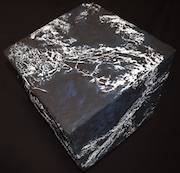



You must be logged in to post a comment.